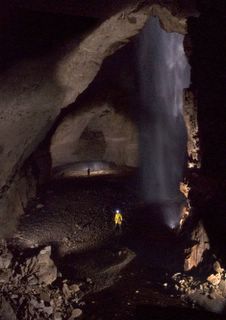Having learned from the Gaping Gill experience, I put the flashguns in zip-lock food bags to keep them dry. This caused some problems in that it was difficult to turn the dials on the top to set the auto modes, and also because the light appeared to reflect around the inside of the bags enough to fool the auto sensor into thinking the correct exposure had been achieved before enough light had been emitted. So pictures taken with the flashes on auto were completely under-exposed. I had to use them on manual, which stopped me getting pictures in smaller spaces due to the brightness being too much for the camera. I was able to use a low ISO setting and stop the aperture right down for excellent depth of field and low noise in the pictures, but the flashes had to be at least 6 feet away from the subject, and this was not possible in the confines of the scaffolded entrance shaft.
I took all the pictures on the lowest ISO settings I could get away with, after the problems with noise in the Gaping Gill pictures. One of the flash gun batteries failed early again. The Metz NiCad pack is just old and past it. I have converted the AA cell battery pack from the other flash to take NiMH rechargeable cells, and this lasted the whole trip. I think I will be cutting open the NiCad pack and replacing the cells in that with AA NiHM cells now. The slaves attached to the flashes were constantly being triggered by our cap lamps, which nearly blinded me when I was putting one flash face up on a rock and it went off about 2ft in front of my face! I think the LED lamps we are using these days are far more prone to triggering the slaves, as we never used to have big problems in the past. This was one reason why the old NiCad battery pack ran down. Then every time we got it to recharge the flash ready for another shot, it would get triggered by accident, and we had to wait another few minutes for it to recharge the flash again.
Here are a couple of pictures from the trip (quick roughs, as I have had no time to balance the levels or anything yet).

Curtain in Curry Inlet

